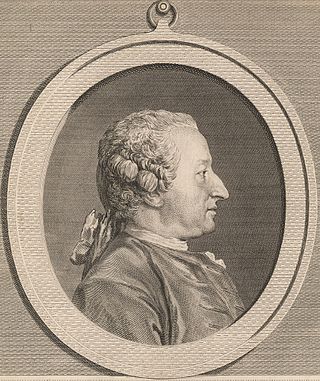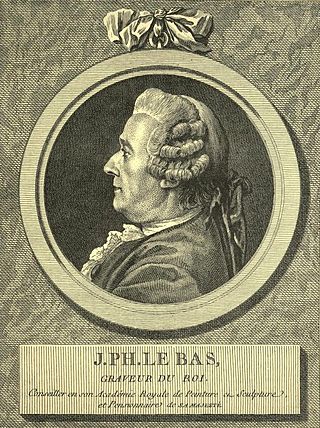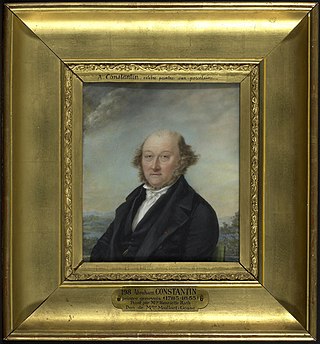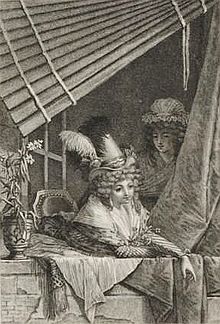
Anne-Louis Girodet de Roussy-Trioson, also known as Anne-Louis Girodet-Trioson or simply Girodet, was a French painter and pupil of Jacques-Louis David, who participated in the early Romantic movement by including elements of eroticism in his paintings. Girodet is remembered for his precise and clear style and for his paintings of members of the Napoleonic family.

Pierre-Paul Prud'hon was a French Romantic painter and draughtsman best known for his allegorical paintings and portraits such as Madame Georges Anthony and Her Two Sons (1796). He painted a portrait of each of Napoleon's two wives.

Louis Hersent was a French painter.

François Pascal Simon Gérard, titled as Baron Gérard in 1809, was a prominent French painter. He was born in Rome, where his father occupied a post in the house of the French ambassador, and his mother was Italian. After he was made a baron of the Empire in 1809 by Emperor Napoleon, he was known formally as Baron Gérard.

Jacques-Henri Sablet was a Swiss-French painter, part of a family of artists of Swiss origin. He was also known as Franz der Römer, Giacomo Sablez, Giacomo Sablé, Jacob Henry Sablet, Sablet le Jeune, Sablet le Romain or le peintre du Soleil.

Pierre Audouin (1768–1822) was a French engraver, and pupil of Beauvarlet.

Charles Boulanger de Boisfremont (1773–1838), one of the pages of Louis XVI, went to America during the Revolution, and there taught himself painting. On his return he commenced exhibiting his works, in which he seems to have adopted Prud'hon as his model. Art is indebted to him for the restoration of the pictures at Versailles when they were in a very bad state of decay. He was born in Rouen on 25 June 1773. He died in Paris on 5 March 1838. He exhibited amongst others the following:

Féréol Bonnemaison was a French portrait painter, lithographer, restorer, and art dealer.

Claudine Bouzonnet-Stella was a French engraver, most of whose prints were after works by Nicolas Poussin, or by her uncle Jacques Stella, from whom she received her artistic education.
Jean-François Cars, was a French engraver, printer, publisher and printseller from Lyon.

Louis-Jacques Cathelin (1738–1804) was a French engraver.

Charles Nicolas Cochin the Elder was a French line-engraver.
Nicolas Cochin (1610–1686), called the Elder, was a French draughtsman and engraver. He was born at Troyes in 1610, the son of a painter named Noel Cochin. About 1635, he went to Paris, where he died in 1686. He often imitated and copied Jacques Callot, but chose for his model Stefano della Bella, some of whose drawings he engraved. Like these two artists he excelled in small figures, which he grouped and delineated with lifelike animation. His specialty was topography, including battles, sieges, and encampments. He engraved several hundred subjects, the most important of which are those he executed for the "Glorieuses Conquêtes de Louis le Grand", called the "Grand Beaulieu", published between 1676 and 1694. The best of these plates may be the "Siege of Arras", engraved on 16 plates by Cochin and Jean Frosne.

Abraham Constantin, a Swiss enamel painter, was born at Geneva. He became a pupil of Gérard, after whom he executed many works in enamel and on porcelain, among which may be mentioned, 'Belisarius,' 'Cupid and Psyche,' 'The Entry of Henry IV. into Paris,' and portraits of the King of Rome, Charles X, and the Emperor of Russia. He was attached to the manufactory at Sèvres, and died at Geneva.

Jean-Louis Anselin was a French engraver. Amongst his best work is an engraved portrait of Madame de Pompadour as "La Belle Jardinière" (pictured).

Adrien Dauzats was a French landscape, genre painter and painter of Oriental subject matter. He travelled extensively throughout the Ottoman Empire and illustrated a number of books for the travel writer, Baron Taylor.
Pierre-Marie Gault de Saint-Germain was a painter and art historian, inspired by the French enlightenment.

Jacob de Bie, known in France also as Jacques de Bie was a Flemish engraver, publisher and numismatist who worked in Antwerp, Brussels, Paris and Arnhem. As a reproductive artist he made engravings after designs of other artists of his generation. He was engaged in numismatic collecting and categorisation and was an official at the mint in Brussels. He is now mainly known for his publication of portraits of French kings.

Louis Binet (1744–1800) was a French painter, draughtsman, illustrator, and engraver.
The Audran family was a French family of engravers and painters, mainly active in Paris and Lyons. The first well-known member was Charles Audran (1594–1674).
















